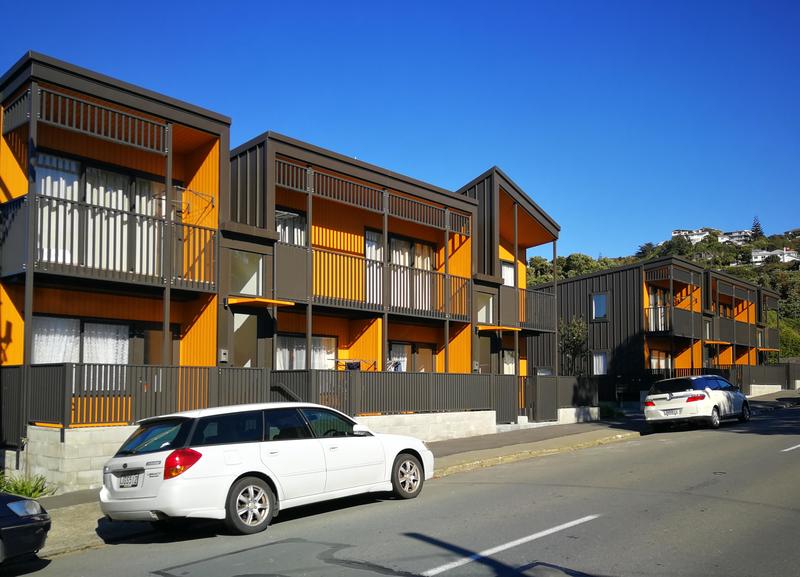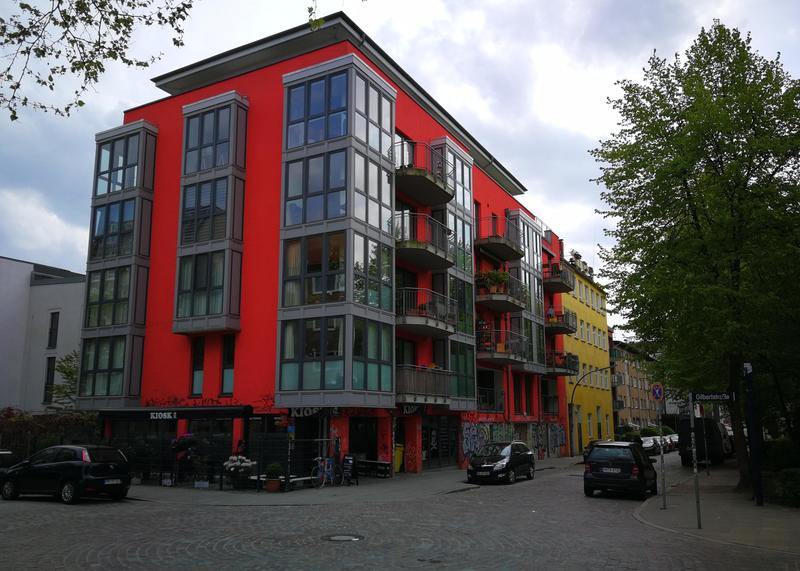Introduction
New Zealand desperately needs more homes, and has done for decades. We’ve got the opportunity to add those new homes well, or badly. So far, we generally haven’t done it well. For decades, urban planners (and even the odd brave politician) have called for our cities to add more housing in their existing areas, rather than sprawling ever outwards. It’s better for the environment, more affordable financially, and in some cities like Wellington a simple geographic necessity. But while our city centres are now home to even more apartments, there’s a “missing middle” of so-called “density done well” that just hasn’t happened.
It’s not much of a mystery why: we don’t get these sorts of intermediate housing like low-rise apartments, terraces, rowhouses, or semi-detached, because mostly our planning system doesn’t allow them. The only common forms of dense housing that most cities can manage is the “sausage flat”, or infill townhouse developments. Even then, they tend to only be allowed in limited areas, and ironically (though not accidentally) in less desirable locations with fewer services and lower quality public transport.
Sausage flats and townhouses are better than nothing. But, because they use land inefficiently, they tend not to provide many more units that the single houses they replaced, while still coming with all of the downsides of denser living (chiefly, a lack of private outside space).
In August, the Ministry for the Environment released a discussion document, “Planning for successful cities”. It’s easy to be cynical about the prospects for change from a government discussion document. But it’s both more readable and more important than you might think. It proposes what it possibly the biggest single piece of national direction towards how our cities should grow in more than half a century. It’s an approach I’ve long thought we need more of, and I’m excited to see it happen. But what does it do, and why?
Growing pains
There are more than 4.9 million people who call New Zealand home. Some time in late 2019 or early 2020 we will hit 5 million. New Zealand’s population growth is well ahead of the world average (1.6% compared to 1.1%), in a world where population growth is mostly in developing countries. Statistics New Zealand projects that over the thirty years from 2013-2043, Wellington could well add up to 80,000 people, Christchurch up to 170,000, and Auckland more than a million, increasing the city in size by two-thirds again. By 2068 there could be as many as 8 million New Zealanders. All of these people will need homes to live in.
These are all the high end of the range projections Stats produced, but part of good planning is about foreseeing all possible eventualities. And even these high estimates don’t account for potential shocks: an influx of climate refugees the Pacific, a Christchurch-type earthquake wiping out a big fraction of a city’s housing stock, or international turmoil causing a mass return home of a big fraction of the more than a million New Zealand citizens who live overseas.
And the supply of housing is already a struggle today. In the last decade rents nationwide rose by 50%, while wages rose only 33%. It’s disproportionate worse in major cities. Rents in Wellington rose 12.5% over the last year alone, vastly outstripping any increase in wages. This is one of the most extreme increases, but the trend is ever upward. Actually buying a house is becoming ever more unaffordable, and based on past trends it’s likely that when the 2018 census data is released, it’ll show that a majority of Aucklanders rent their home rather than own it.
The problem is a fairly basic combination of geometry and economics. People need places to live, and if there’s more people they need more houses. If the houses aren’t there, prices will rise to ration the scarcity out, and those unable to pay will end up trapped in relationships they can’t afford to end, living in cramped flats or with family well into adulthood. At its worst, the shortage leads to people living in caravans, garages, cars, or simply sleeping rough. Even those fortunate enough not to worry about that will still find themselves paying far more than they should for worse housing in a worse location.
Why grow up?
If we’re going to build new houses, they need to go somewhere. New Zealand’s traditional approach, from pretty much the earliest days of Pākehā settlement, was to spread outwards, enabled by first railways and trams, and by the mid-20th century, the car. New Zealand’s cities have pretty low population density by the standards of Western Europe or developed countries in Asia, although still generally ahead of the United States.
But urban sprawl has geographic, ecological, and financial limits, and many New Zealand cities are reaching them, or in some cases reached them decades ago. The alternative is a word that’s certainly become loaded - intensification.
New Zealand planners have talked for nearly half a century, and politicians for about a decade, about taming sprawl and instead, making better use of the urban land we already have. Building buildings that are taller, are on smaller lots, use a bigger fraction of their sites, or are better designed internally to allow people to live comfortably in a smaller unit.
Intensification, unlike sprawl, also allows a graceful landing from the spiral of house prices.
 New terraced houses in Berhampore, Wellington. This site is council-owned social housing. For a private sector developer, getting approval for this sort of thing is difficult without assembling a single large site, and even then, there will often be severe limits on how many units can be built. Photo: author.
New terraced houses in Berhampore, Wellington. This site is council-owned social housing. For a private sector developer, getting approval for this sort of thing is difficult without assembling a single large site, and even then, there will often be severe limits on how many units can be built. Photo: author.
Why should central government direct it?
Legions of plans made by local governments have talked about how desirable intensification might be. Some progress has been made: many cities allow granny flats, or splitting existing houses into two. While not usually permitted as-of-right, it’s common to be able to get a resource consent for a couple of townhouses on a site where a single house once stood.
But the problem is simply scale. Local governments talk a big talk about allowing intensification, but when it comes to the test, the capacity for growth is whittled away, piece by piece, and remains far too conservative to have a noticeable impact. Auckland and Wellington both theoretically allow denser development in their inner suburbs, within a few kilometres (walking distance!) of the central city. But in both cases, that principle is subject to “character” restrictions that prevent any major changes in areas with older buildings. Except that those character areas cover practically the entire area of those inner suburbs.
You can theoretically get resource consent for a development beyond what zone rules allow. But council planning departments tend to be conservative. While on the big scale, the effect of developments adds up and has a big effect on housing supply, for each individual development, mostly the only people who are are the developer on one side and a handful of neighbours on the other. Planners take their lead from councillors, who are always more worried about homeowning voters than a single property developer.
Central government has the luxury of avoiding this problem. Central government elections are on a scale that not even the biggest single housing development is going to sway an election. People also tend to vote along broader, abstract concerns like “the cost of housing” or “the environment”. In local elections, there’s a tendency to lose the forest for the trees. Ultimately, we also see central government as the backstop, and expect it to step in when local government can’t handle the issues.
The Resource Management Act provides numerous ways that central government can direct how the planning system should work. In this case, it’s through the issue of what’s called a “National Policy Statement” or NPS. The NPS can direct councils to put or not put certain things in their plans, and to consider or not consider certain things in making decisions1. It can require councils to conduct research in certain areas before regulating.
Does that mean no growing out?
What the government proposes doesn’t prevent cities from growing out as well. In a sense it even requires councils to provide for outward growth more than they have before, which you could see as worrying. If you dig in a bit deeper, though, the detail of the proposal is about taming sprawl, and not as alarming and haphazard as some of the marketing has suggested.
The core of how the NPS works is that it will require councils in major urban areas2 to prepare a “Future Development Strategy”. This must provide for some outward growth, which wasn’t required before. But it also requires councils to provide for intensification. The outward growth also needs to be spatially planned in advance, meaning that council needs to have a good idea of which long term infrastructure will be needed like roads, public transport, reserves, water, and so on. Councils will be free to stop sprawl that doesn’t meet what’s set out in this plan, or that meets the plan but where no public or private funding is available for infrastructure.
Which rules stand in the way?
But back to intensification. The District Plans written by councils control development. Under the RMA, plans are expected to figure out which land uses have environment effects, and where those effects are negative, to restrict them.
The problem is that denser housing developments are considered by these plans to be an environmental negative. Obviously, denser living is generally better for the environment than urban sprawl. But the definition of “the environment” in the the RMA includes quite a lot of matters that aren’t in the normal use of the word. These “effects” generally are quite prescriptive, and embody prescriptive mid-20th century ideas about what the right way to live is. In most plans, having a one- or two-storey single detached house on a section of 400 to 1000 square metres is seen as the normal baseline. Everything else isn’t banned, by any means. But everything else has to be endlessly, and expensively, justified on the grounds of being pretty similar to detached houses in look and feel.
You can build apartments, but they need to look like detached houses, through a whole host of detailed rules: height limits, height in relation to boundary, front yards, side yards, rear yards, site coverage, impervious coverage, landscaping, building separation, ground level open space. You’ve got to provide lawns even for people who don’t use them, because they have much better parks nearby. Most cities have at least some zones that effectively limit the number of kitchens a house can have, just in case someone were to separately rent out part of their house. It’s difficult to connect that back to a “negative” “effect” on the “environment”, and most councils pay only lip service in trying. For the most part these rules simply were carried over from the much more paternalistic and prescriptive planning systems of the 20th century.
Planning rules are not the only obstacle to building denser housing. Often the very layout of our cities can make well-designed projects harder - many of our streets are too wide, and our parcels of land are too narrow and too deep. There can be a lack of builders with experience with attached and taller buildings. There can also be a lack of financial capacity for mid-sized projects, too small for Fletcher, but too big for cashed-up homeowners. But planning rules are absolutely the biggest obstacle, and a prerequisite to dealing with the others. It’s possible we won’t even know what the scale of other obstacles is, until developers have the freedom to have a go.
How will the NPS change that?
The NPS on Urban Development will move on from mere encouragement, and require councils to open up existing residential areas for redevelopment and so allow terraced houses, apartments, and so on. One option is to leave the choice of areas up to councils. But in general, that’s the approach that’s been tried and failed before. The more prescriptive approach will have central government direct these areas by formula: anywhere within 1.5km of the city centre, or within 800m of high-quality public transport.
Which sort of higher density housing will be allowed is also not yet decided, but the approach suggested is also a prescriptive one. Councils would have some flexibility but in general their zone rules would have to allow at least a certain number of dwellings per hectare, or a certain floor area. It’s possible some rules could be overridden: for example allowing three-storey buildings as of right, despite height limits or recession planes.
The exact details of how this will be accomplished is what the discussion documents is asking for feedback on, so we’ll get to that later.
 A contemporary apartment building in Hamburg, Germany. While many European cities are much loved for their mid-rise historic cores, it’s possible to replicate those advantages over a wider area with new buildings in inner suburbs. If you’re wondering about the grafitti, Hamburgers try to cultivate a hip, countercultural vibe and generally let grafitti stay. Photo: author.
A contemporary apartment building in Hamburg, Germany. While many European cities are much loved for their mid-rise historic cores, it’s possible to replicate those advantages over a wider area with new buildings in inner suburbs. If you’re wondering about the grafitti, Hamburgers try to cultivate a hip, countercultural vibe and generally let grafitti stay. Photo: author.
Why all the fuss about parking?
One of the most important things the NPS will do is tackle parking requirements. I’ve written before about ending parking minimums, so I won’t retread it too much. The short is that they waste land, sabotage good urban design for buildings, and subsidise and encourage driving, despite most climate and urban planning theoretically aiming to limit driving and provide alternatives.
Professional planning has certainly moved over the last decade or so, towards seeing parking requirements as bad policy. The move certainly isn’t complete. Even when politicians provide support for ending minimums, the old guard of planners, and big box retailers can make councils drag their feet. Auckland’s Unitary Plan removed commercial parking requirements from town centres just to have the move blocked by unelected commissioners, under pressure from court action by big retailers.
Central government doesn’t need to play by any of the ludicrously complex requirements that apply to local government decision making, and mostly doesn’t face a threat of serious court action. The NPS proposes several options for parking, and one is removing parking requirements completely.
That would be a game-changer for New Zealand’s cities. It’s maybe the single biggest obstacle in designing good quality denser housing, particularly when the parking isn’t actually necessary. It also continually undermines our attempts to improve our public transport and walking and cycling options, by subsidising the private car.
What can you do?
If you want a New Zealand that grows up about growing up its cities, and responsibly provides for growth, I suggest you give your feedback to the Ministry for the Environment. While the consultation is in principle asking for technical feedback, it’s a deeply political decision, and your support will help keep the government committed to action, and not get spooked by pushback from reactionaries.
I’ve made a guide to making a submission, which should give you some pointers whether you want to send a simple message of support or a more detailed look into some of the questions they pose. Submissions close on 10 October 2019.
 Wellington has built a fair number of new apartments in the heart of the city, but the suburbs immediately surrounding the city centre haven’t kept pace, leaving primarily extremely expensive detached houses. This leaves most people with a very binary choice: an apartment in the busy downtown, or a very long commute. Photo: author.
Wellington has built a fair number of new apartments in the heart of the city, but the suburbs immediately surrounding the city centre haven’t kept pace, leaving primarily extremely expensive detached houses. This leaves most people with a very binary choice: an apartment in the busy downtown, or a very long commute. Photo: author.
Notes
-
While it seems odd, large parts of our planning system operate through a system of “restricted discretion” - planners, politicians, comissioners, and judges can make a completely subjective decision, but they need to explain their reasoning, and it needs to show that certain things have been considered and others haven’t. Often councils create these restrictions for themselves, both as a guide for planners to let them know what’s important, and as a way of avoiding fighting about the same issue over and over by making a single decision and sticking to it. ↩
-
Auckland, Christchurch, Hamilton, Queenstown, Tauranga, and Wellington. ↩
